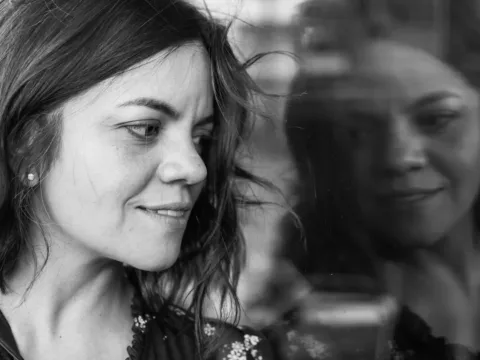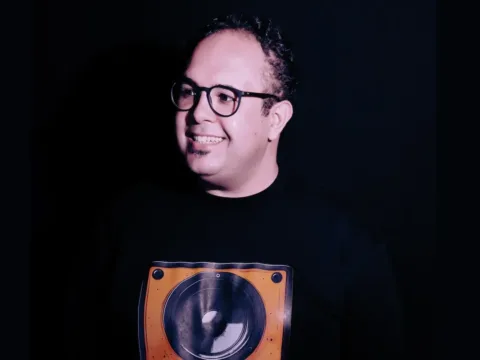ListN Up playlists are commissioned by American Composers Forum. Artists are selected by ACF staff (including I CARE IF YOU LISTEN and innova Recordings).
Jeremiah Chiu is a Los Angeles-via-Chicago artist and musician working with Chicago’s venerable International Anthem Recording Co., whom released his solo record, In Electric Time, his duo record with Marta Sofia Honer, Recordings from the Åland Islands, and his quintet SML’s Small Medium Large to critical acclaim. He is an electronic music composer and sound-artist who’s work has been featured/exhibited by The Getty Center, LACMA, Cincinnati Contemporary Art Center, The Chicago Cultural Center, and the Museum of Contemporary Art, Chicago, amongst others. Most recently, he has toured with Sam Prekop & John McEntire, Mary Lattimore, and was the opener for M83 on their U.S. Fantasy Tour.
Hi, my name is Jeremiah Chiu. I am an artist, musician, graphic designer, and educator working primarily in sound through the use of synthesizers, samplers, and live recording techniques. I’m originally from Chicago, and currently live in Los Angeles. The playlist I’ve curated today are a good reflection of music that has stuck with me over the past few decades that I still reference, listen to, and study pretty regularly. It’s a selection that I love, featuring Raymond Scott, Franco Battiato, Laurie Speigel, Tortoise, and more. It was quite hard to select only a few tracks, so I attempted to have it feel as narrative and cohesive as possible, and you should be able to hear my influences quite clearly. I really hope your enjoy, thanks.
The Rhythm Modulator by Raymond Scott
I first became aware of Manhattan Research, Inc. in the early 2000s when I was beginning to learn synthesis. The recordings on Manhattan Research range from pure studio experiments to commercial snapshots, methodically moving from one idea to the next. I love the unedited archival quality of this set of recordings, complete with vocalized take numbers and thoughts. I revisit Scott’s work often as it’s endlessly inspiring in its sheer amount of ideas, simplicity, and analog goodness. The music shows the breadth of his abilities as a composer for more traditional instrumentation and his pension for pure sonic experimentation. The moments of accidental proto-techno are still unmatched, in my opinion.
I cancelli della memoria by Franco Battiato
Franco Battiato’s early 70’s albums are always a top pick recommendation for me. These early records seamlessly combine folk, found sound, music concrete, experimental approaches, studio magic, and synthesizers into hyper cohesive albums. I cancelli della memoria is a track that I always reference when I’m finalizing an album of my own. While a lot of the music I make is often categorized as Ambient, my reference points are much more aligned to classical minimalism, early electronic, and experimental music—Battiato, David Behrman, Laurie Spiegel, Daphne Oram, Terry Riley, etc…
Kristallo by Kraftwerk
This may be the first time that I’ve pulled this distinct track title out of the album, Ralf und Florian, as I think I’ve only ever listened to the album in its entirety as a more singular piece. I find the sound of Ralf und Florian to feel quite closely aligned to many contemporary approaches to improvisation in Los Angeles right now. While their intention in 1973 Germany may not have been to combine classical minimalism, trance, jazz, and experimental music, they certainly created a work that continues to inspire future generations. Here I am, laying my cards on the table that I’d be happy to create something that sounded close to this—human, vibey, experimental, improvised, ever-expanding.
Rain Dance by Herbie Hancock, Performed by Hancock, Bennie Maupin, Eddie Henderson, Julian Priester, Buster Williams, Billy Hart, Patrick Gleeson, Buck Clarke
This is just an absolute stunner of a classic album that never gets old to me—1973 and still sounding extremely fresh. Rain Dance is probably my most referenced track for the sound of my quintet, SML. Our approach is fully improvised and all of our recordings to-date have been made in front of an audience. When improvising on modular synth, I try to strike a balance between tonal/atonal, rhythmic sequenced/rhythmic played, and live-sampling/live manipulation. Patrick Gleeson has perfected synthesizers in a jazz environment as evidenced here.
Drums by Laurie Spiegel
While Laurie’s most well-known synthesizer songs express her ability to create complex melody through minimal means. Her song, Drums, strips back the layers for me, allowing me to hear her rhythmic approach through pinging filters alone. I love this song because I also primarily use filter resonance as a percussive tone, creating things that are woody and marimba-like. Drums also allowed me to hear her practice amongst the work of composers like Steve Reich, John McGuire, and other minimalists.
diskhat 1 by Aphex Twin
From the incredible album, Computer Controlled Instruments Pt. 2, diskhat1 is the perfect thesis—part Cagean prepared piano, part James Brown break beat, part computer programming genius. This album is highly recommended on vinyl as it’s the rare album that states, “play at 33 or 45”—composed to work at either speed. This is another deep reference for me—as you can probably see now—for it’s perfect blend of analog and electronic.
Poppy Nogood and the Phantom Band by Terry Riley
I’ve been reading about and experimenting recently with Terry Riley’s “time-lag accumulator”—a reel-to-reel delay system that feels his playing through two reel-to-reel tape machines and back through themselves to create “magic”. When improvising, I often use several different live-sampling techniques to capture myself or other musicians, which I then shift to working the sampled material. The capture can then be played using granular synthesis techniques—manipulating small grains of audio, or a more traditional tape-splice approach.
Dolphins by Ryuichi Sakamoto
For the past 15 years, I’ve been obsessed with all things in the YMO (Yellow Magic Orchestra) universe—the solo output of Sakamoto, Hosono, Takahashi, Yano, Ono, etc… This song, Dolphins, showcases Sakamoto’s masterful handle on soundscape, melody, studio techniques, space, and (with it’s title) playfulness. I always love when I find a piece of music where I can’t quite tell how it was made. Meaning, while I hear the sounds and production, it’s unclear if it was played, programmed, collaged, processed, or a combination of all of these techniques. And process aside, it’s human, and resonates on a purely musical level
Djed by Tortoise
Tortoise is probably the band that I’ve listened to the most regularly since discovering them in the late 90s. In college, I had a CD player alarm clock that woke me up to Tortoise’s TNT every morning. That same CD is still in my car CD player two-plus decades later. I chose Djed prolong this playlist and end with song that traverses so much music, so many ideas. I once had a professor that told me, don’t try to say everything with every piece that you make, just try to say something. Djed does both for me.
I CARE IF YOU LISTEN is an editorially-independent program of the American Composers Forum, funded with generous donor and institutional support. Opinions expressed are solely those of the author and may not represent the views of ICIYL or ACF.
A gift to ACF helps support the work of ICIYL. For more on ACF, visit the “At ACF” section or composersforum.org.
























